Impact of Rotation Speed of Ball Milling on P4O10 Size Thus on Promotion of CO2 Reduction Performance with P4O10/TiO2 Photocatalyst
Abstract
1. Introduction
2. Results and Discussion
2.1. Characterization of Prepared Photocatalyst
2.2. CO2 Reduction Performance of P4O10/TiO2 with Changing Molar Ratio of CO2/H2O at the Rotation Speed of 600 rpm
2.3. CO2 Reduction Performance of P4O10/TiO2 with Changing Rotation Speed and Light Illumination Conditions
3. Experimental Procedure
3.1. Preparatioon Procedure of P4O10/TiO2
3.2. Characterization Procedure of P4O10/TiO2
3.3. Experimental Procedure of CO2 Reduction
4. Conclusions
- (i)
- It was revealed that the particle size of P4O10/TiO2 prepared by the rotation speed of 600 rpm was the smallest among the investigated rotation speeds. The average diameter of P4O10 particles prepared at the rotation speeds of 600 rpm, 400 rpm and 200 rpm was 0.523 μm, 0.762 μm and 0.746 μm, respectively.
- (ii)
- It was revealed that the concentration of formed CO as well as the molar quantity of CO per unit weight of photocatalyst P4O10/TiO2 prepared at the rotation speed of 600 rpm in the case of CO2:H2O = 1:1 is the highest among the different molar ratios, irrespective of light illumination condition.
- (iii)
- In the case of CO2:H2O = 1:1 under the light illumination condition of IR, the following findings were obtained: The concentration of formed CO for the rotation speed of 600 rpm was 254 ppmV, which is 9.8% more than that prepared at 400 rpm and 27.0% more than that prepared at 200 rpm. The molar quantity of CO per unit weight of photocatalyst for the rotation speed of 600 rpm was 11.9 μmol/g under the light illumination condition of IR, which is 1.8% more than that prepared at 400 rpm and 8.2% more than that prepared at 200 rpm.
Author Contributions
Funding
Data Availability Statement
Conflicts of Interest
References
- Jesic, D.; Jurkovic, L.D.; Pohar, A.; Suhadolnik, L.; Likozar, B. Engineering Photocatalytic and Photoelectrocatalytic CO2 Reduction Reactions: Mechanisms, Intrinsic Kinetics, Mass Transfer Resistances, Reactors and Multi-scale Modeling Simulations. Chem. Eng. J. 2021, 407, 126799. [Google Scholar] [CrossRef]
- Kaushik, R.; Singh, P.K.; Halder, A. Modulation Strategies in Titania Photocatalyst for Energy Recovery and Environmental Remediation. Catal. Today 2022, 384–386, 45–69. [Google Scholar] [CrossRef]
- Wang, Z.W.; Shi, Y.Z.; Liu, C.; Kang, Y.Y.; Wu, L. Cu+-Ti3+ Interface Interaction Mediated CO2 Coordination model for Controlling the Selectivity of Photocatalytic Reduction CO2. Appl. Catal. B Environ. 2022, 301, 120803. [Google Scholar] [CrossRef]
- Remiro-Buenamanana, S.; Garcia, H. Photoassisted CO2 Conversion into Fuels. ChemCatChem 2019, 11, 342–356. [Google Scholar] [CrossRef]
- Hong, L.F.; Guo, R.T.; Yuan, Y.; Ji, X.X.; Lin, Z.D.; Gu, J.W.; Pan, W.G. Urchinlike W18O49/g-C3N4 Z-Scheme Heterojunction for Highly Efficient Photocatalytic Reduction of CO2 under Full Spectrum Light. Energy Fuels 2021, 35, 11468–11478. [Google Scholar] [CrossRef]
- Dai, W.; Yu, J.; Luo, S.; Hu, X.; Yang, L.; Zhang, S.; Li, B.; Zou, J. WS2 Quantum Dots Seeding in Bi2S3 Nanotubes: A Novel Vis-NIR Light Sensitive Photocatalyst with Low-Resistance Junction Interface for CO2 Reduction. Chem. Eng. J. 2020, 389, 123430. [Google Scholar] [CrossRef]
- Gan, J.; Wang, H.; Hu, H.; Su, M.; Chen, F.; Xu, H. Efficient Synthesis of Tunable Band-Gap CuInZnS Decorated g-C3N4 Hybrids for Enhanced CO2 Photocatalytic Reduction and Near-Infrared-Triggered Photordegradation Performance. Appl. Suf. Sci. 2021, 564, 150396. [Google Scholar] [CrossRef]
- Yu, M.; Lv, X.; Idris, A.M.; Li, S.; Lin, J.; Lin, H.; Wang, J.; Li, Z. Upconversion Nanoparticles Coupled with Hierarchical ZnIn2S4 Nanorods as a Near-Infrared Responsive Photocatalyst for CO2 Reduction. J. Colloid Interface Sci. 2022, 612, 782–791. [Google Scholar] [CrossRef] [PubMed]
- Nishimura, A.; Mae, H.; Kato, T.; Hu, E. Utilization from Ultraviolet to Infrared Light for CO2 Reduction with P4O10/TiO2 Photocatalyst. Phys. Astron. Int. J. 2022, 6, 145–154. [Google Scholar] [CrossRef]
- Nishimura, A.; Mae, H.; Hanyu, R.; Hu, E. Impact of Loading Amount of P4O10 on CO2 Reduction Performance of P4O10/TiO2 with H2O Extending Absorption Range from Ultraviolet to Infrared Light. Phys. Astron. Int. J. 2022, 6, 186–194. [Google Scholar] [CrossRef]
- Moulder, J.F.; Stickle, W.F.; Sobol, P.E. Handbook of X-Ray Photoelectron Spectroscopy: A Reference Book of Standard Spectra for Identification and Interpretation of XPS Data, 1st ed.; Chastain, J., King, R.C., Jr., Eds.; ULVAL-PHI, Inc.: Chigasaki, Japan, 2010; pp. 15–17. [Google Scholar]
- Goren, Z.; Willner, I.; Nelson, A.J. Selective Photoreduction of CO2/HCO3- to Formate by Aqueous Suspensions and Colloids of Pd-TiO2. J. Phys. Chem. 1990, 94, 3784–3790. [Google Scholar] [CrossRef]
- Tseng, I.H.; Chang, W.C.; Wu, J.C.S. Photoreduction of CO2 Using Sol-gel Derived Titania and Titania-supported Copper Catalysts. Appl. Catal. B 2002, 37, 37–38. [Google Scholar] [CrossRef]
- Izumi, Y. Recent Advances in the Photocatalytic Conversion of Carbon Dioxide to Fuels with Water and/or Hydrogen Using Solar Energy and Beyond. Coord. Chem. Rev. 2013, 257, 171–186. [Google Scholar] [CrossRef]
- Japan Society of Mechanical Engineering. Heat Transfer Hand Book, 1st ed.; Maruzen: Tokyo, Japan, 1993; pp. 367–369. [Google Scholar]
- Inoue, Y.; Yokoyama, T.; Tanaka, T.; Yutama, T. Analysis of Grinding Rate in a Tumbling Ball Mill by Three-Dimensional DEM. J. Mech. Eng. Jpn. (C) 2000, 641, 1–8. [Google Scholar] [CrossRef][Green Version]
- Moulder, J.F.; Stickle, W.F.; Sobol, P.E.; Bomben, K.D. A Reference Book of Standard Spectra for Identification and Interpretation of XPS data. In Handbook of X-Ray Photoelectron Spectroscopy; ULVAC PHI, Inc.: Chigasaki, Japan, 2010. [Google Scholar]
- Zhu, M.; Kim, S.; Mao, L. Metal-free Photocatalyst for H2 Evolution in Visible to Near-infrared Region: Black Phosphorus/Graphitic Carbon Nitride. J. Am. Chem. Soc. 2017, 139, 13234–13242. [Google Scholar] [CrossRef] [PubMed]
- Nishimura, A.; Ishida, N.; Tatematsu, D.; Hirota, M.; Koshio, A.; Kokai, F.; Hu, E. Effect of Fe Loading Condition and Reductants on CO2 Reduction Performance with Fe/TiO2 Photocatalyst. Int. J. Photoenergy 2017, 2017, 1625274. [Google Scholar] [CrossRef]
- Nishimura, A.; Senoue, H.; Mae, H.; Hanyu, R.; Hu, E. CO2 Reduction Performance with Double-layered Cu/TiO2 and P4O10/TiO2 as Photocatalyst under Different Light Illumination Conditions. Catalysts 2024, 14, 270. [Google Scholar] [CrossRef]
- Licensable Patent Information Database. P2009-184861A. 2022. Available online: https://plidb.inpit.go.jp (accessed on 31 March 2025).

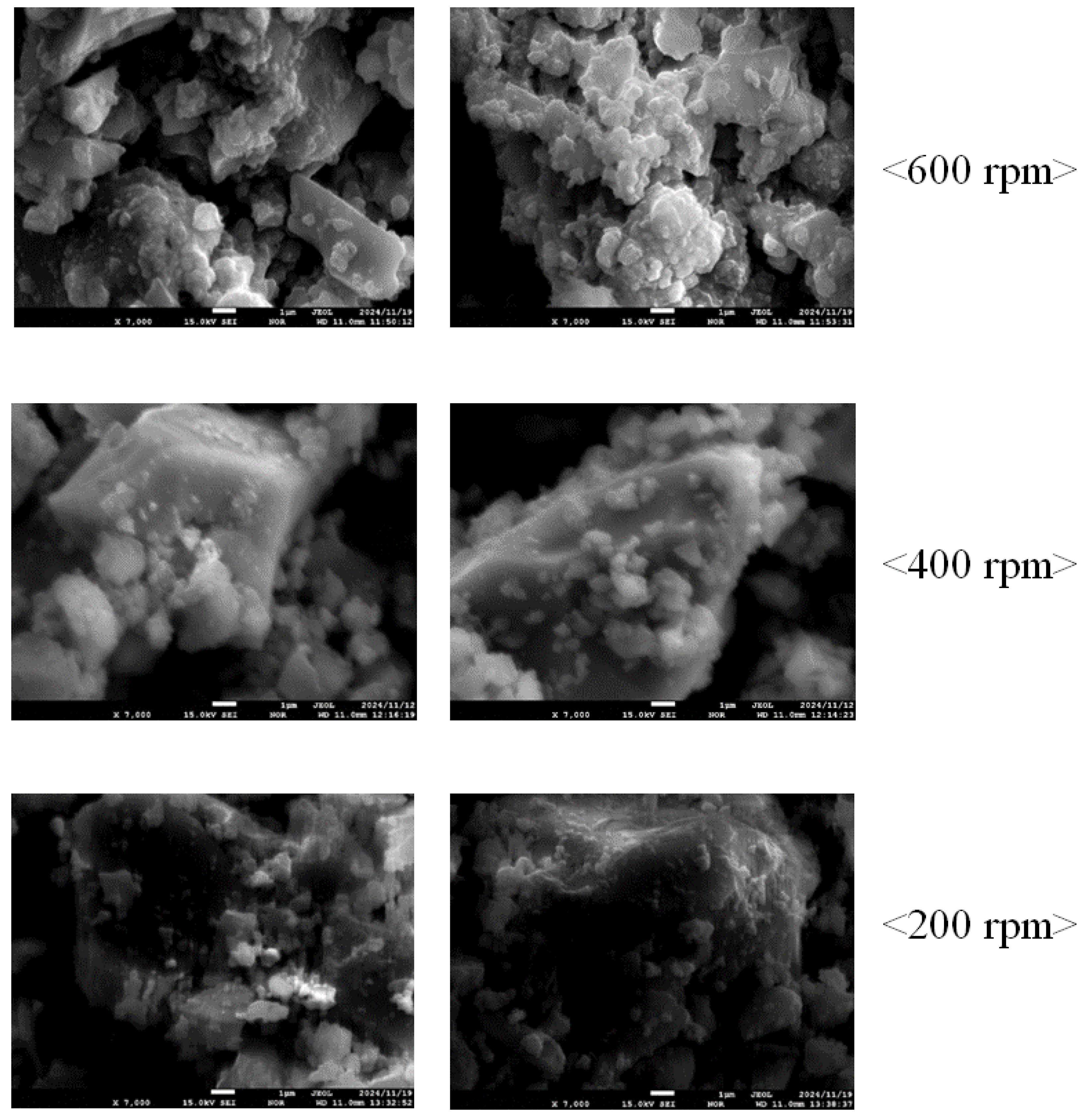
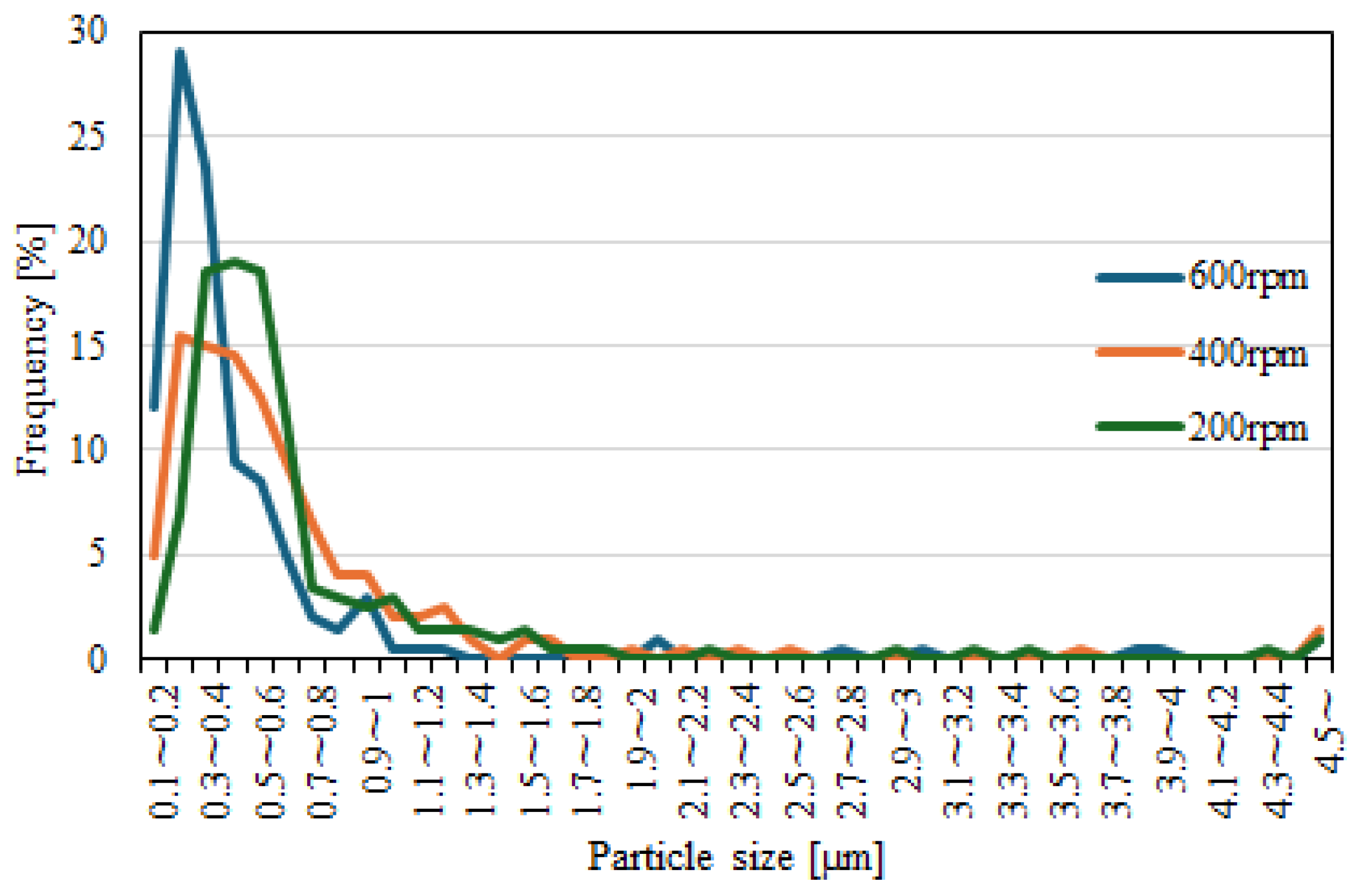
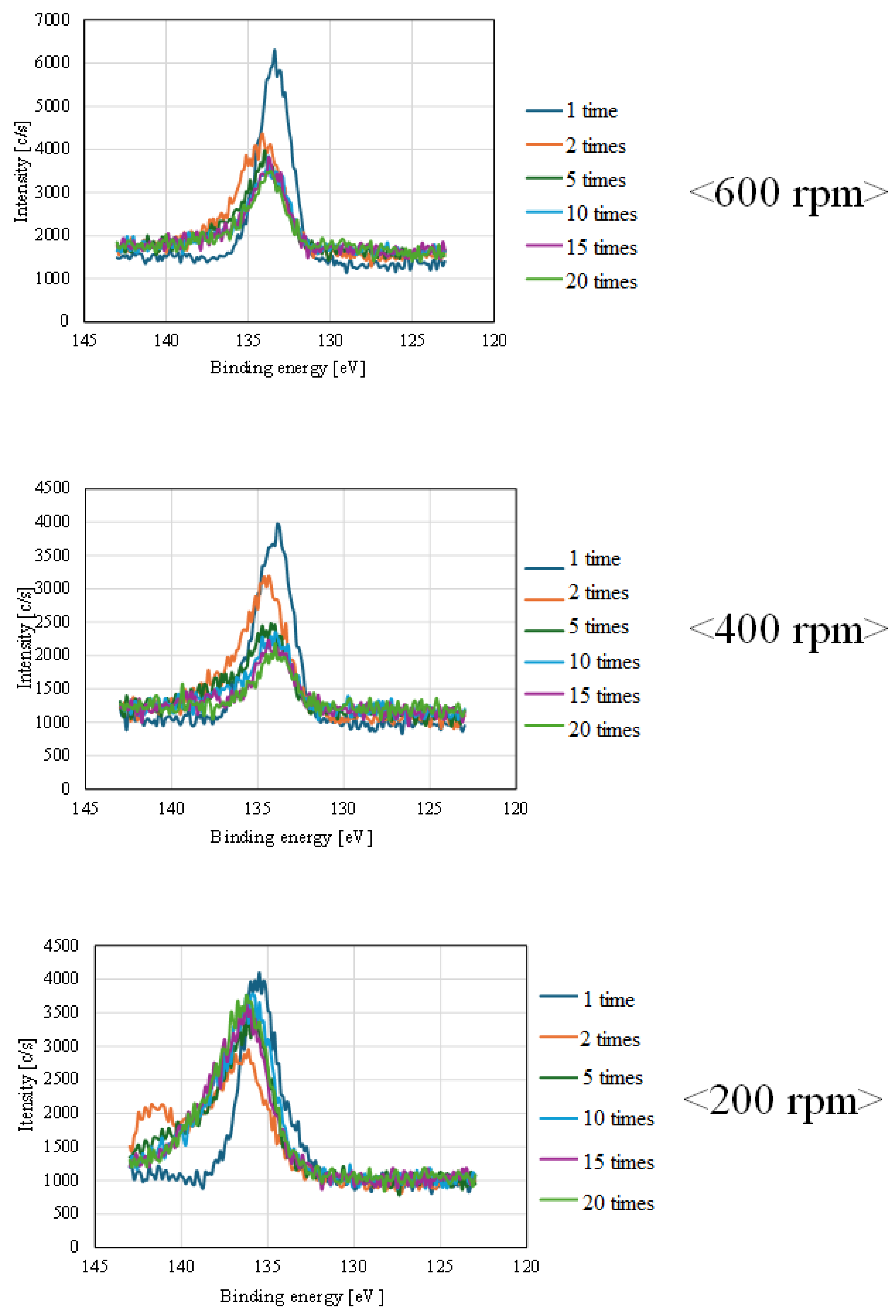


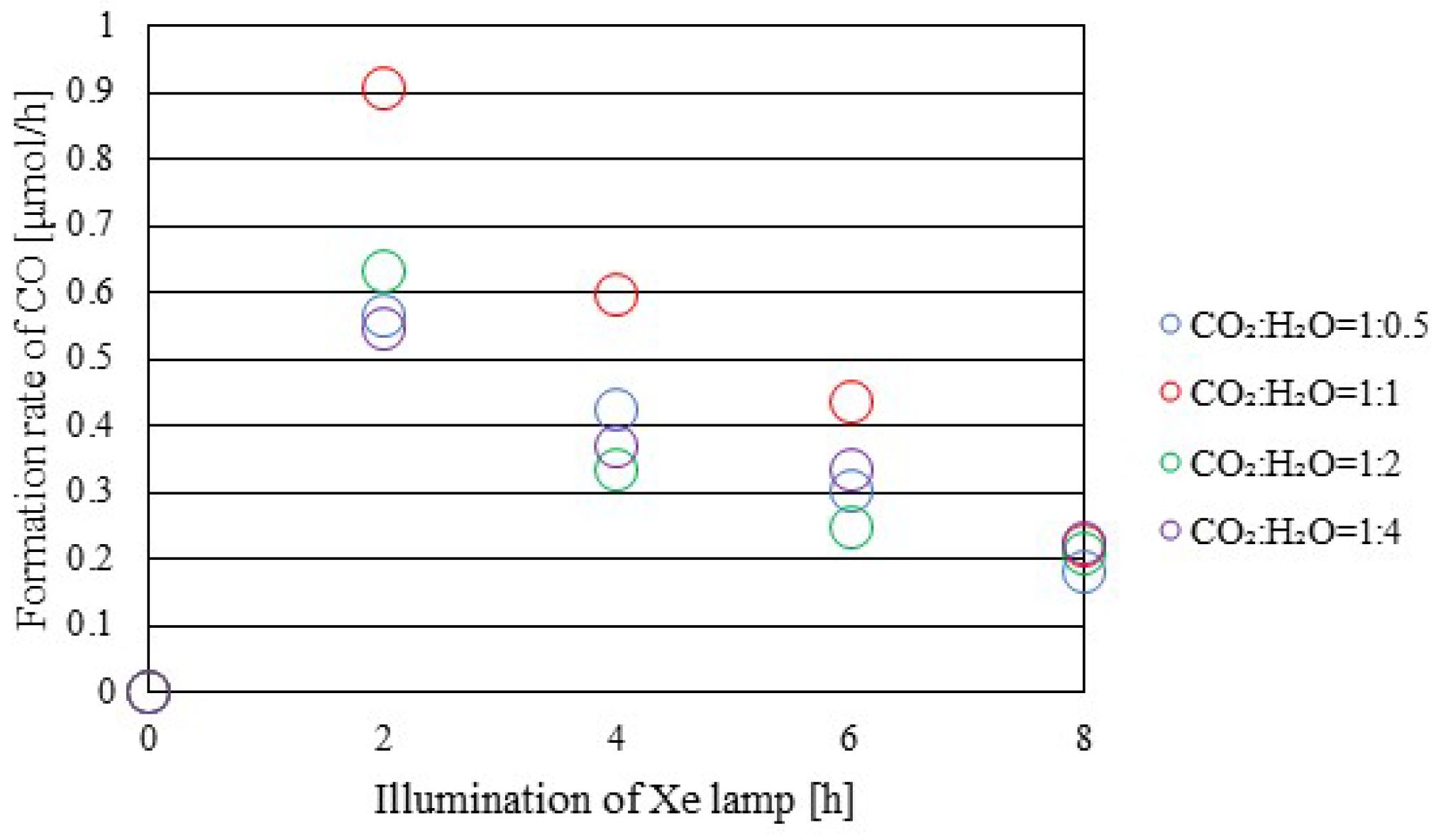



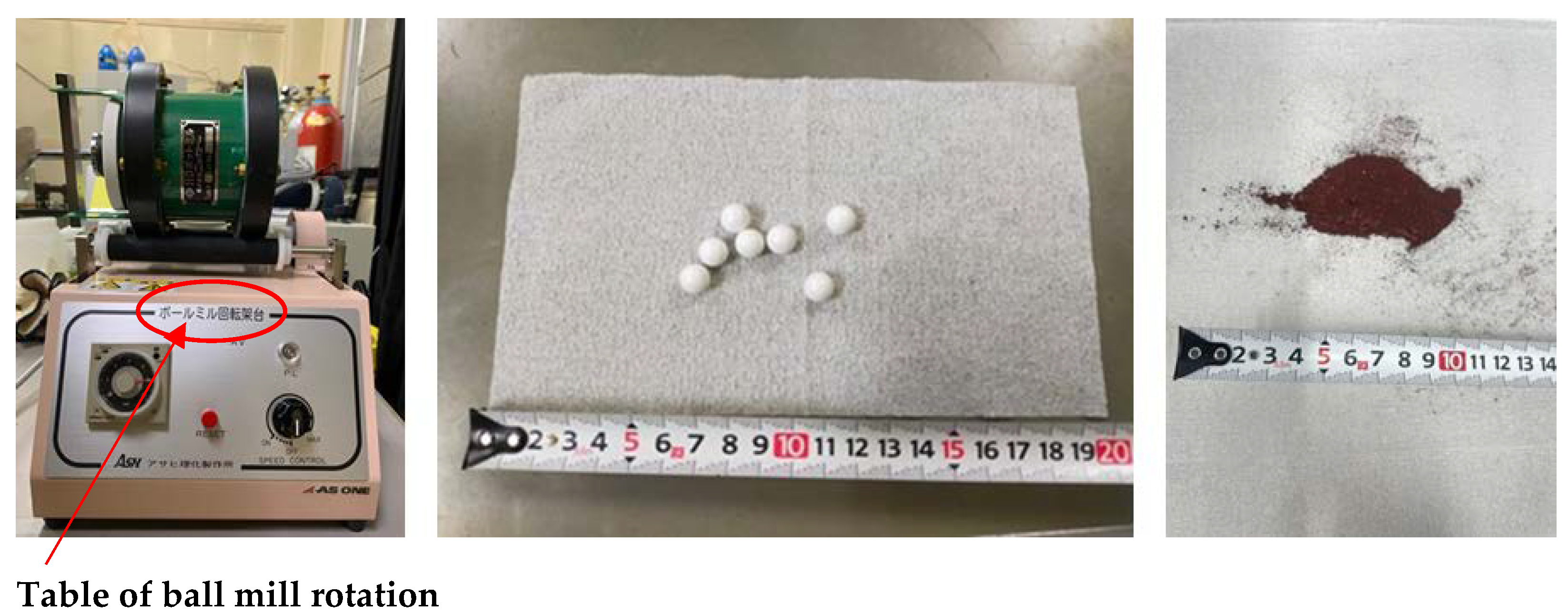
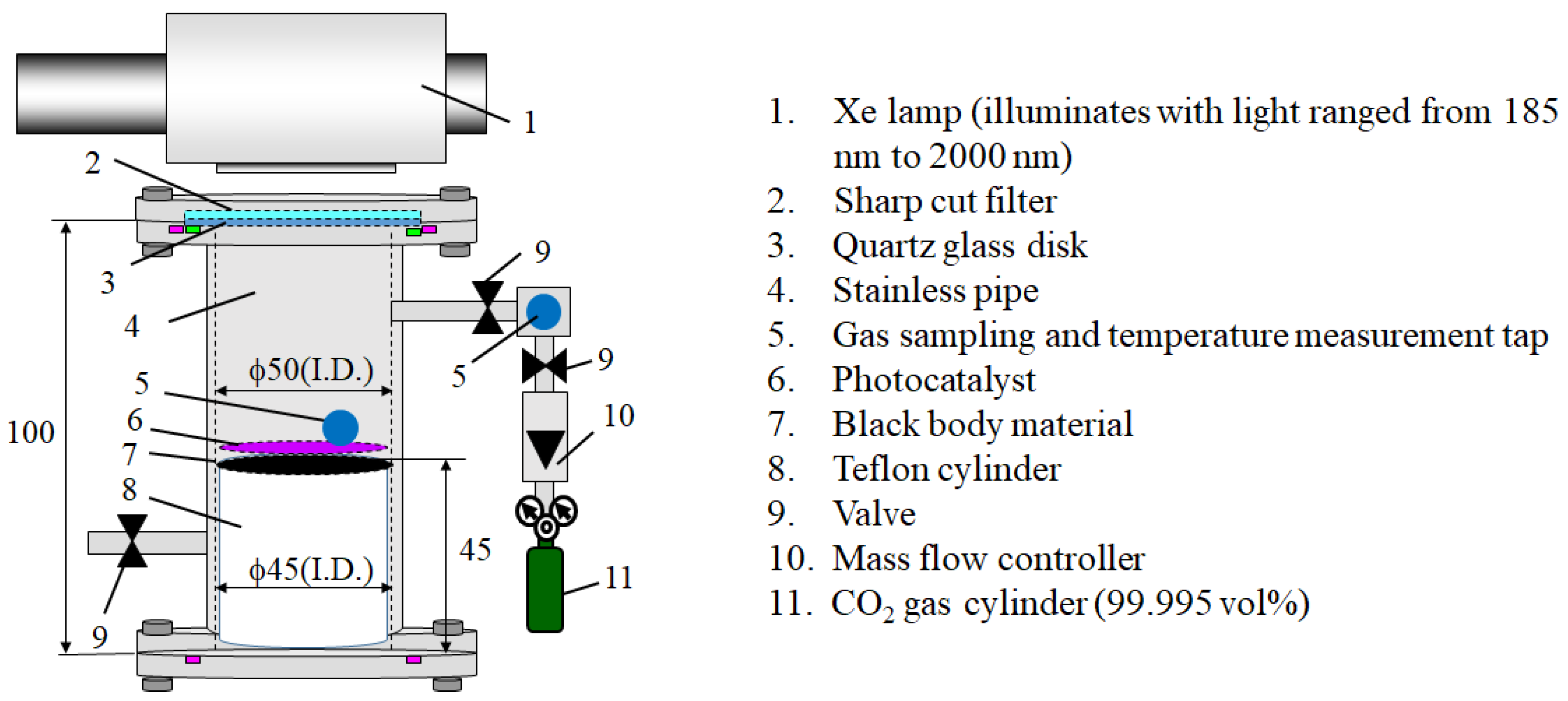
Disclaimer/Publisher’s Note: The statements, opinions and data contained in all publications are solely those of the individual author(s) and contributor(s) and not of MDPI and/or the editor(s). MDPI and/or the editor(s) disclaim responsibility for any injury to people or property resulting from any ideas, methods, instructions or products referred to in the content. |
© 2025 by the authors. Licensee MDPI, Basel, Switzerland. This article is an open access article distributed under the terms and conditions of the Creative Commons Attribution (CC BY) license (https://creativecommons.org/licenses/by/4.0/).
Share and Cite
Nishimura, A.; Saito, T.; Hanyu, R.; Senoue, H.; Hu, E. Impact of Rotation Speed of Ball Milling on P4O10 Size Thus on Promotion of CO2 Reduction Performance with P4O10/TiO2 Photocatalyst. Catalysts 2025, 15, 448. https://doi.org/10.3390/catal15050448
Nishimura A, Saito T, Hanyu R, Senoue H, Hu E. Impact of Rotation Speed of Ball Milling on P4O10 Size Thus on Promotion of CO2 Reduction Performance with P4O10/TiO2 Photocatalyst. Catalysts. 2025; 15(5):448. https://doi.org/10.3390/catal15050448
Chicago/Turabian StyleNishimura, Akira, Toru Saito, Ryo Hanyu, Hiroki Senoue, and Eric Hu. 2025. "Impact of Rotation Speed of Ball Milling on P4O10 Size Thus on Promotion of CO2 Reduction Performance with P4O10/TiO2 Photocatalyst" Catalysts 15, no. 5: 448. https://doi.org/10.3390/catal15050448
APA StyleNishimura, A., Saito, T., Hanyu, R., Senoue, H., & Hu, E. (2025). Impact of Rotation Speed of Ball Milling on P4O10 Size Thus on Promotion of CO2 Reduction Performance with P4O10/TiO2 Photocatalyst. Catalysts, 15(5), 448. https://doi.org/10.3390/catal15050448






